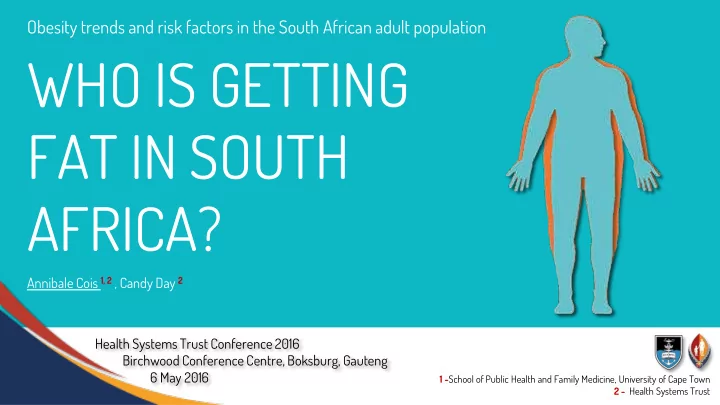

Obesity trends and risk factors in the South African adult population WHO IS GETTING FAT IN SOUTH AFRICA? Annibale Cois 1, 2 , Candy Day 2 Health Systems Trust Conference 2016 Birchwood Conference Centre, Boksburg, Gauteng 6 May 2016 1 - School of Public Health and Family Medicine, University of Cape Town 2 - Health Systems Trust
Background ! LITTLE DOUBT EXISTS THAT THE PREVALENCE OF OBESITY AND OVERWEIGHT IS ON THE RISE GLOBALLY IN SOUTHERN IN SOUTH AFRICA AFRICA HST Conference 2016
Background 1.6 0.9 0.7 kg/m 2 per kg/m 2 per decade kg/m 2 per decade 0.5 decade kg/m 2 per decade Females 2.9 1.4 kg/m 2 per 0.4 1.0 decade kg/m 2 per kg/m 2 per kg/m 2 per decade decade decade Males World Southern Africa South Africa HST HST Conference Conference Modified from: Finucane et al. Lancet. 2011;377(9765):557-67. 2016 2016
obese Background Estimated distribution of BMI in the South African adult population: Females overweight normal weight underweight HST Conference Data from: Ardington & Case. Cape Town. SALDRU. 2009 2016
Background Estimated distribution of BMI in the South African adult population: Males normal weight overweight obese underweight HST Conference Data from: Ardington & Case. Cape Town. SALDRU. 2009 2016
Background ? WHO WHAT IS DRIVING THIS TREND? ? HST Conference 2016
Background ? WHO IS DRIVING THIS TREND? ? HST Conference 2016
IDENTIFY SUBGROUPS IN THE SOUTH AFRICAN ADULT POPULATION CHARACTERISED BY DIFFERENT Aims TRAJECTORIES OF CHANGE IN BODY MASS INDEX IDENTIFY SOCIOECONOMIC, BIOLOGICAL AND BEHAVIOURAL CHARACTERISTICS DIFFERENTIANG THESE GROUPS HST Conference 2016
A PUBLIC HEALTH PERSPECTIVE TARGET BURDEN OF Aims INTERVENTIONS DISEASE UNMODIFIABLE AND MODIFIABLE CHARACTERISTICS HST Conference 2016
Methods First Wave: Second Wave: Third Wave: Fourth Wave: 2008 2010 2012 2014 Panel survey of a nationally representative sample of the SA population • ~28 000 subjects interviewed in 2008 and recontacted every 2 years • In this study: data on 10 100 subjects 18+ at baseline and successfully recontacted • in 2010 and 2012 HST www.nids.uct.ac.za Conference 2016
DATA ANALYSIS Growth Mixture Modelling (GMM) was used to identify latent classes of subjects characterised by distinct patterns of change in BMI during the study period. Methods A multinomial logistic regression model was fit to identify significant predictors of class membership Gender SOCIOE Alcohol use Education BEHAV BIO Age Smoking Household income Waist circumference Physical exercise Urban vs. rural residence HST Conference 2016
1 AVERAGE BMI (AND THUS OBESITY PREVALENCE) ARE STILL RISING IN THE SOUTH AFRICAN ADULT POPULATION 1.8 (1.1 – 2.6) 1.0 Results kg/m 2 per 1.6 decade (0.1 – 1.9) kg/m 2 per kg/m 2 per Females Males 2.9 decade decade kg/m 2 per decade HST Conference 2016
AN ASIDE: WAIST CIRCUMFERENCE IS INCREASING, TOO … Females Kernel density estimate, weighted Results HST HST Conference Conference 2016 2016
… AMONG MALES AS WELL Males Kernel density estimate, weighted Results HST HST Conference Conference 2016 2016
POPULATION IS NOT HOMOGENEOUS: SOME 2 PEOPLE ARE PUTTING ON WEIGHT FASTER THAN OTHERS (AND SOME ARE LOSING IT) Obese stable ( 12.3% ) Results Normal (relatively) stable ( 82.1% of the population) HST HST Conference Conference 2016 2016
3 PEOPLE THAT ARE INCREASING FASTER THEIR WEIGHT ARE: RURAL DWELLERS WOMEN RATHER WITH GREATER AT THE EXTREMES OF THAN MEN WAIST THE INCOME CIRCUMFERENCE DSITRIBUTION OR adj = 2.7 OR adj = 1.7 OR adj = 2.3 2.0 OR adj = 1.9 per 10 cm increase HST Conference 2016
ARE RURAL PEOPLE ‘ CATCHING UP ’ WITH URBANITES? Results BMI Linear regression estimates from NiDS survey, weighted HST 2008 2010 2012 Conference 2016
4 PEOPLE THAT ARE DECREASING THEIR WEIGHT FASTER ARE: SMOKERS, NON DRINKERS, EXERCISE MODERATELY MEN RATHER THAN WOMEN OR adj = 7.6 OBESE WITH SMALLER WAIST OR adj = 0.1 OR adj =14 OR adj = 11.0 HST OR adj = 2.0 per 10 cm decrease Conference 2016
5 AGE HAS A COMPLEX EFFECT, COMPATIBLE WITH THE HYPOTHESIS THAT YOUNG PEOPLE ARE LESS STABLE. Results COMPARED TO OLDER PEOPLE, THEY ARE MORE LIKELY EITHER TO INCREASE OR DECREASE THEIR WEIGHT HST Conference 2016
Conclusions HST HST Conference Conference 2016 2016
A strong positive trend in BMI remains in South Africa and obesity prevalence is likely to increase in the next years Trends are not homogeneous, and high risk groups (subjects at the extreme of the income distribution, rural dwellers, women) and modifiable risk factors (physical inactivity, alcohol use) can be targeted Conclusions Subjects quitting smoking should receive additional weight-loss support in order that the numerous health benefits of cessation are not reduced by increasing BMI Further research is needed on the role of central obesity HST Conference 2016
STRENGTHS WEAKNESSES • Large sample • Low reliability of self-report data for • Longitudinal study risk factors • Direct measurement • Absence of reliable data on nutrition of weight and height • Low response rates and high • Efficient treatment of attrition in some social strata missing data and • Choice of number of classes in GMM Strenghts & Weknesses random measurement • Only three waves available error HST Conference 2016
THANK YOU! annibale.cois@uct.ac.za This study has received financial support from the Programme to Support Pro-Poor Policy Development II (PSPPD II), a partnership between the Presidency, Republic of South Africa and the European Union. Health Systems Trust Conference 2016, Birchwood Conference Centre, Boksburg, Gauteng
Recommend
More recommend